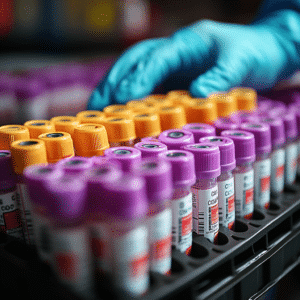Understanding the Basics: What Is ROSC?
ROSC, or Return of Spontaneous Circulation, is a critical term mostly seen in emergency and critical care settings. Essentially, when someone’s heart begins to beat on its own after having stopped, that’s ROSC. It’s an essential step towards recovery from cardiac arrest. Grasping the concept of ROSC helps in comprehending resuscitation techniques like cardiopulmonary resuscitation (CPR) and advanced cardiac life support (ACLS). For anyone who has faced the scare of an overdose or heart failure, knowing about ROSC can be life-altering.
ROSC: Decoding the Term
To grasp what ROSC is, we need to break down the abbreviation. ROSC stands for “Return of Spontaneous Circulation.” This term points to the moment when a patient’s heart begins to beat without any external help following cardiac arrest. Understanding this can shed light on the life-saving work done by medics.
| Aspect | Details |
| Definition | Return of Spontaneous Circulation (ROSC) refers to the return of a sustained perfusing rhythm that results in adequate blood flow after cardiac arrest. |
| Detection Methods | – Arterial Pulse Palpation (requires stopping chest compressions) – End-tidal CO2 Monitoring (requires endotracheal intubation) |
| Achieved Through | – Cardiopulmonary Resuscitation (CPR) – Defibrillation |
| Initial Actions Post-ROSC | – Monitor patient until the Advanced Cardiac Life Support (ACLS) team takes over – Check for breathing and pulse – Stop CPR/AED use |
| Importance | Necessary for survival after cardiac arrest. Indicates a temporary return of circulatory function. |
| Prognosis | While ROSC is favorable, it does not predict a favorable medium- or long-term outcome. Some patients may die shortly after circulation is restored. |
| Outcome Monitoring | Continuous monitoring of vital signs, including pulse and breathing, is essential. |
| Emergency Processes | – Look for signs of life – Provide airway support – Prepare for advanced interventions by ACLS team |
The Importance of ROSC: Clinical Significance and Impact
Achieving ROSC is pivotal in emergency care. It signifies that resuscitation efforts are working. When ROSC is reached, it marks the beginning of stabilizing a patient and gives a chance to work towards their recovery. It’s a watershed moment that can massively influence the patient’s chances of survival and long-term health outcomes.
What Does ROSC Mean in Emergency Medical Situations?
In emergency scenarios, achieving ROSC is a turning point. It signifies that the patient’s heart and blood flow are regaining functionality, offering a ray of hope. Emergency medical teams employ multiple techniques to achieve ROSC, including high-quality chest compressions, defibrillation, and airway management. The ultimate goal is to restore blood flow to the heart and brain, increasing the likelihood of survival and improved neurological health.
Top 5 Strategies to Achieve ROSC
Which of These Best Describes the Purpose for Hands-Only CPR?
Hands-only CPR focuses solely on chest compressions, bypassing mouth-to-mouth resuscitation. Simplified by the American Heart Association (AHA), its main purpose is to encourage more people to perform CPR in emergencies. It has proven to be effective in increasing the chances of achieving ROSC, especially in out-of-hospital scenarios.
Comparative Analysis: Hands-Only CPR vs. Traditional CPR
Studies have shown compelling results. For instance, data from the New England Journal of Medicine in 2023 indicated that hands-only CPR achieved similar rates of ROSC and hospital discharge survival as traditional CPR for out-of-hospital cardiac arrests. Its simplicity means more people are willing to perform it, potentially saving countless lives. Understand the benefits hands-only CPR can bring by trying your hand at a fun project like solving Sunday Crosswords, which also stimulates the brain and keeps you sharp in emergencies.
Innovative Perspectives: The Future of ROSC and Resuscitation Techniques
The field of resuscitation is continually advancing. Innovations such as mechanical chest compression devices, personalized defibrillation protocols, and AI integration in emergency response are showing promise. These changes can revolutionize how we approach cardiac arrest and ROSC globally, offering better patient outcomes.
Key Takeaways for Parents from Mothers Against Addiction
At Mothers Against Addiction, we understand the incredible stress of dealing with a child’s addiction, where overdose emergencies can occur. Knowing about ROSC and how to react can be the difference between life and death. Keep in mind that achieving ROSC is only the beginning; several considerations like post-ROSC care are just as crucial. For example, knowing the difference between naltrexone Vs naloxone, and understanding the interactions of trazodone And alcohol, can help you be better prepared in emergencies.
Being informed about ROSC, its significance, and the strategies to achieve it can offer hope and clarity during those critical moments where every second counts. Stay educated, stay prepared, and let’s make a difference together.
For those who want to dig deeper into these subjects or need additional support, our resources at Mothers Against Addiction offer comprehensive support and information. Join us on this journey towards better outcomes and understanding. Whether you’re checking out 1989 vinyl collections or Demon Slayer funko pop figurines, staying aware could make all the difference when faced with an emergency.
Feel free to use our tools like the mortgage calculator by payment and mortgage calculator Tennessee to manage your financial goals. Let’s keep hope alive together!
By understanding what ROSC is, you’re arming yourself with the knowledge that could one day save a life. Stay informed, stay compassionate, and lead with resilience.
What is ROSC?
ROSC, short for Return of Spontaneous Circulation, is an essential milestone in emergency medical care, especially when dealing with heart-related incidents. But what makes ROSC so vital, and what is it really all about?
The Miracle of Life
When a person experiences cardiac arrest, their heart stops beating effectively, cutting off vital blood supply to the brain and other organs. Achieving ROSC means that the heart has started pumping blood again on its own. This is truly a life-and-death moment. Fun fact: research shows that every minute ROSC is delayed during cardiac arrest, survival rates drop by about 10%.
Parker Valley hope, a rehabilitation center known for its compassionate approaches, emphasizes quick response and proper intervention during such emergencies. Without the right measures, the absence of oxygen can lead to devastating brain damage within minutes.
Numbers Paint a Picture
To put ROSC into perspective, let’s talk numbers. In the U.S. alone, over 350,000 cardiac arrests occur outside of hospitals each year. Staggeringly, just 10-20% of those are lucky enough to achieve ROSC. The odds go up significantly with immediate CPR and advanced medical care. Isn’t that something?
Considering these statistics, it’s clear why training programs at Parker Valley Hope stress the importance of CPR and timely intervention. By understanding what ROSC is and its critical role, we’re better prepared to respond to cardiac emergencies effectively.
A Chain Reaction
The journey to achieving ROSC often starts well before the emergency unit arrives. It hinges on a chain of survival steps—early recognition, swift emergency calls, effective CPR, rapid defibrillation, and advanced life support—all working like clockwork. This chain can be the difference-maker when precious seconds are ticking by.
Imagine you’re in a situation where someone collapses; quick thinking and immediate action using CPR techniques could save a life. Many programs, like those at Parker Valley Hope, aim to educate the public on these life-saving steps.
In knowing more about what is ROSC, we’re not only informed but empowered to act confidently during critical moments. After all, understanding these crucial details can be the key to unlocking survival for those in need.
What do you do if ROSC is achieved?
When ROSC is achieved, keep a close eye on the patient until the advanced cardiac life support team arrives. Make sure to check their breathing and pulse, and stop CPR and AED use.
Can you get ROSC from CPR?
Yes, you can get ROSC from performing CPR. Cardiopulmonary resuscitation, often accompanied by defibrillation, significantly increases the likelihood of ROSC.
Is ROSC a good thing?
ROSC is definitely a positive sign because it means the heart has started beating again. However, it doesn’t guarantee a good long-term outcome since many patients might not survive long after.
How do we confirm ROSC has been achieved?
ROSC is confirmed mainly by feeling the arterial pulse and monitoring end-tidal CO2 levels. It’s important to stop chest compressions to palpate the pulse and to intubate for accurate CO2 monitoring.
What should you do after ROSC is achieved?
After ROSC is achieved, just keep monitoring the patient’s vital signs like breathing and pulse until help arrives. You don’t continue CPR or use the AED anymore.
What is the treatment for ROSC?
The treatment for ROSC involves advanced cardiac life support, which includes monitoring and stabilizing the patient, ensuring they are breathing, managing airway, and keeping an eye on their vital signs.
Can CPR revive someone with no pulse?
Yes, CPR can revive someone with no pulse. By performing chest compressions and rescue breaths, you can sometimes restore circulation and breathing.
What are the odds of ROSC after CPR?
The odds of achieving ROSC after CPR depend on numerous factors including the cause of cardiac arrest and how quickly CPR was initiated. The chances can vary widely.
Can CPR alone restart a heart?
CPR alone can sometimes restart a heart, especially when started quickly after cardiac arrest. However, defibrillation often improves the chances of a successful outcome.
What are the stages of ROSC?
The stages of ROSC generally include the return of a detectable pulse, rise in blood pressure, and improvement in overall consciousness and breathing.
What drugs are given after ROSC?
After ROSC, various drugs may be given, such as adrenaline (epinephrine) and anti-arrhythmics, as guided by advanced cardiac life support protocols.
Can you get ROSC without defibrillation?
It’s possible to achieve ROSC without defibrillation, especially if the cardiac event didn’t involve a shockable rhythm. However, defibrillation often boosts the chances.
Do you stop CPR if ROSC?
Once ROSC is achieved, you stop CPR. The focus should shift to monitoring and stabilizing the patient.
Do you continue chest compressions after ROSC?
No, you don’t continue chest compressions after ROSC. The priority is to monitor their pulse and breathing and support them until advanced help arrives.
How often does ROSC happen?
ROSC happens in a significant number of cases where CPR and defibrillation are promptly and effectively administered, but it varies based on the situation.
What is the first treatment priority for a patient who achieves ROSC?
The first treatment priority for a patient who achieves ROSC is to ensure they have a stable airway and are breathing adequately. Monitoring vital signs closely is also essential.
What priority actions should you take if a patient shows signs of ROSC?
If a patient shows signs of ROSC, immediately stop CPR, check their breathing and pulse, and get ready for more advanced care from medical professionals.
What should you do if ROSC is achieved in Quizlet?
If ROSC is achieved in a Quizlet context, the steps are the same: stop CPR, check for pulse and breathing, and prepare for advanced cardiac life support.
What initial interventions are appropriate for the initial stabilization of a patient who has achieved ROSC?
Initial stabilization of a patient who has achieved ROSC includes ensuring they have a clear airway, adequate breathing, and stable circulation. Monitoring vital signs and supporting organ function are also key.




























